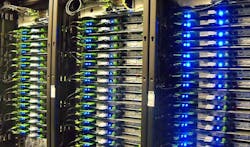The Year in Cloud: A Busy Year for Facebook Data Centers
When clicking through the most-read cloud stories on Data Center Frontier in 2017, you’ll find a steady stream of news relating to Facebook cloud and its data centers that support it. Below are five of our most popular stories this year, which also serve to paint a picture of Facebook’s full 2017 year.
Facebook has been busy this year, expanding its AI programs and enormous data center campuses, as well as addressing arc flash incidents head on with the public.
In other Facebook data center news, the social media giant has also built a new dedicated network to speed up traffic between data centers. Top environmentally-friendly news this year also included headlines about Facebook’s efforts to use heat energy from servers in its data centers to heat homes.
Here are five of the top-read stories on Data Center Frontier from 2017:
Construction on Facebook’s data center campus in Prineville, Oregon in July 2016. (Photo: Rich Miller)
Feb. 20: Facebook Building Even Bigger Data Center Campuses: When Facebook unveiled its first company-built data center on the high plains of Central Oregon in 2011, it was a first step into the larger world of hyperscale cloud campuses. As it approaches 2 billion users, Facebook is hitting a new phase of growth, which includes building even larger data centers, and more data centers on each cloud campus. Read more.
March 8: With Big Basin, Facebook Beefs Up its AI Hardware: Facebook is beefing up its high performance computing horsepower with Big Basin, an AI server powered by eight NVIDIA GPU accelerators. Big Basin was introduced at this year’s Open Compute Summit. Read more. [clickToTweet tweet=”Top News from Facebook in 2017: Building Bigger, Beefing Up #Hardware and Networks. #datacenters ” quote=”Top News from Facebook in 2017: Building Bigger, Beefing Up #Hardware and Networks. #datacenters”]
May 1: Facebook Express Network Speeds Traffic Between Data Centers: Facebook delivers an enormous amount of data to its 2 billion users, including the photos and videos you share with your friends. As data volumes have soared along with its growth, Facebook has built a dedicated network to manage the huge flows of machine-to-machine M2M traffic between its data centers. Read more.
Big Basin, the new machine learning AI server Facebook introduced today at the Open Compute Summit in Santa Clara, Calif. (Photo: Facebook)
Sept. 5: Using Servers to Heat Homes — Facebook Embraces Heat Recycling: The latest company to embrace the strategy of using servers to heat homes is Facebook, which announced that its cloud campus in Odense, Denmark will connect to a neighborhood district heating system. Facebook will use heat energy from servers in its data center in Denmark to warm up to 6,900 nearby homes through a district heating system. Read more.
Oct. 19: Facebook — Open Sharing Was Key to Addressing Arc Flash Incidents: Data center operators don’t love talking publicly about failure. Ranking high on the list of those unwelcome failures is arc flash. (FYI – An arc flashis the light and heat produced as part of an arc fault, a type of electrical explosion or discharge that results from a low-impedance connection through air to ground or another voltage phase in an electrical system. These can be a life safety issue in the data center.) At the 7×24 Exchange Fall Conference, Facebook disclosed two arc flash incidents at its data center in Sweden, and how its post-event analysis headed off other potential incidents. Read more.
To read more and make sure you stay up to date on Facebook data center news, see here.
Keep pace with the fact-moving world of data centers and cloud computing by following us on Twitter and Facebook, connecting with Data Center Frontier editor Rich Miller on LinkedIn, and signing up for our weekly newspaper using the form below.





